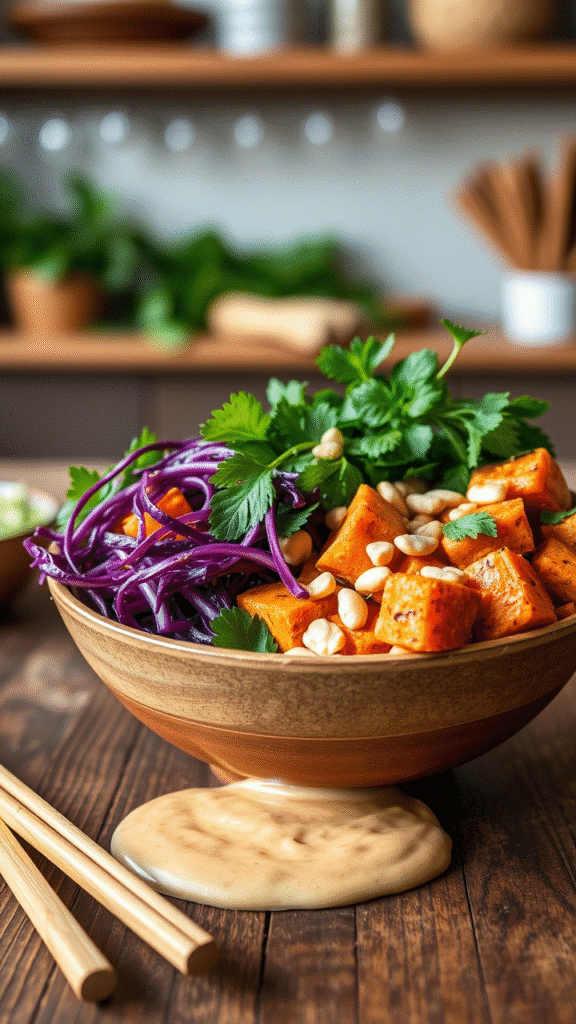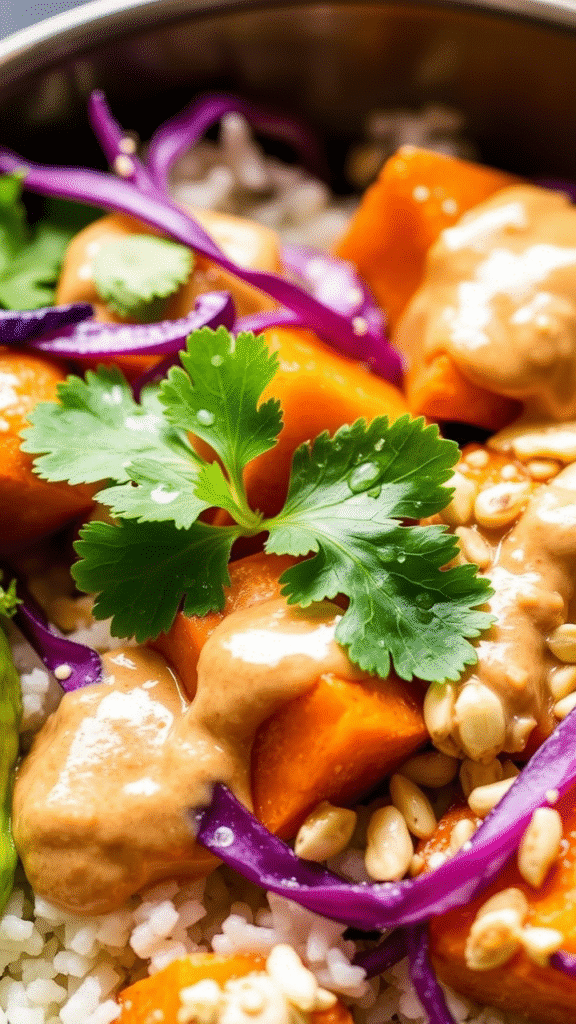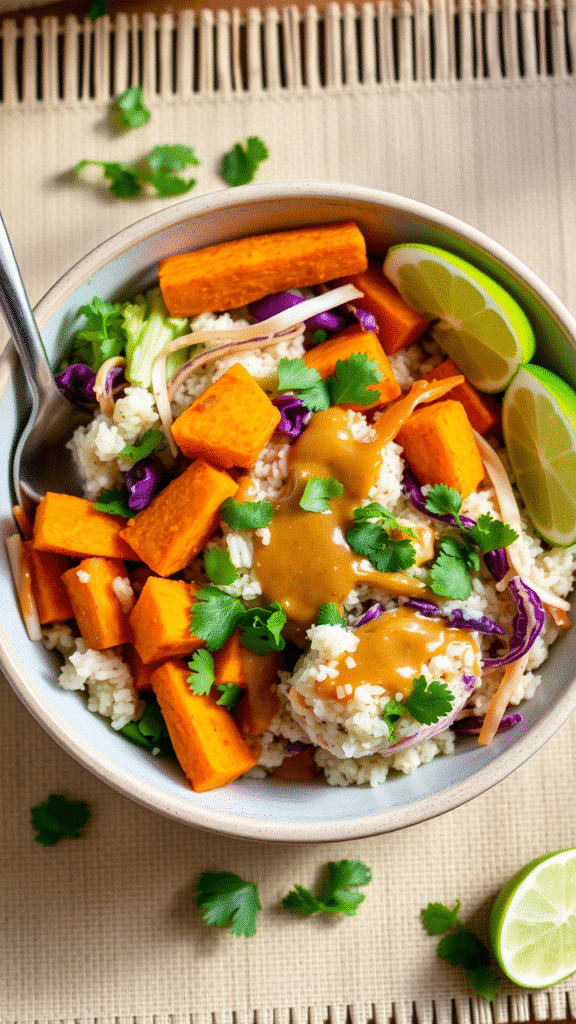Last Tuesday, I watched a seasoned line cook at one of Bangkok’s most respected vegetarian restaurants assemble what looked like edible art in a bowl. The precision was mesmerizing—each component perfectly placed, colors that seemed to pulse with life, and that unmistakable aroma of toasted peanuts mingling with lime and chili. That’s when I realized the Thai Peanut Sweet Potato Buddha Bowl isn’t just another trendy dish; it’s a masterclass in balancing textures, flavors, and nutritional density.
This isn’t your typical grain bowl thrown together with whatever’s lurking in your refrigerator. The Thai Peanut Sweet Potato Buddha Bowl represents a sophisticated marriage of Southeast Asian flavor profiles with the mindful eating philosophy that defines Buddha bowl cuisine. What makes this particular variation extraordinary is how it transforms humble sweet potatoes into caramelized jewels that anchor a symphony of fresh herbs, crunchy vegetables, and that legendary Thai peanut sauce that somehow manages to be both comforting and exotic.
The secret lies in understanding that each element serves a specific purpose beyond mere nutrition. The sweet potatoes provide earthy sweetness and creamy texture. Fresh vegetables add crunch and brightness. The peanut sauce becomes the flavor conductor, tying everything together with its complex interplay of sweet, salty, spicy, and tangy notes.
Understanding the Buddha Bowl Philosophy
Buddha bowls emerged from the concept of mindful eating, where every ingredient contributes to both physical nourishment and visual harmony. The Thai interpretation elevates this concept by incorporating the fundamental principles of Thai cuisine: the balance of sweet, sour, salty, and spicy flavors in every bite.
Professional kitchens have embraced this dish because it’s infinitely customizable while maintaining structural integrity. You can prep components ahead of time, making it perfect for meal prep services or restaurants with high volume demands. The key is understanding which elements can be prepared in advance and which require last-minute attention.
Ingredients & Substitutions
For the Roasted Sweet Potatoes:
- 2 large sweet potatoes (about 2 pounds), peeled and cubed into 1-inch pieces
- 2 tablespoons coconut oil or avocado oil
- 1 teaspoon ground cumin
- 1/2 teaspoon smoked paprika
- 1/2 teaspoon kosher salt
- 1/4 teaspoon black pepper
For the Thai Peanut Sauce:
- 1/2 cup natural peanut butter (smooth or crunchy)
- 3 tablespoons soy sauce or tamari
- 2 tablespoons rice vinegar
- 2 tablespoons lime juice (about 1 large lime)
- 1 tablespoon honey or maple syrup
- 1 tablespoon sesame oil
- 2 cloves garlic, minced
- 1 teaspoon fresh ginger, grated
- 1-2 teaspoons sriracha or chili garlic sauce
- 2-4 tablespoons warm water (for thinning)
For the Bowl Base:
- 2 cups cooked quinoa or brown rice
- 4 cups mixed greens (baby spinach, arugula, or kale)
- 1 large cucumber, diced
- 1 red bell pepper, julienned
- 1 cup shredded purple cabbage
- 1 cup edamame, shelled and cooked
- 1 avocado, sliced
- 1/4 cup fresh cilantro leaves
- 1/4 cup fresh mint leaves
- 2 green onions, sliced thin
- 2 tablespoons toasted sesame seeds
- 1/4 cup crushed peanuts
The beauty of this recipe lies in its adaptability. Sweet potatoes can be substituted with butternut squash or even roasted cauliflower for lower-carb options. However, I’ve found that sweet potatoes provide the ideal textural contrast and natural sweetness that harmonizes with the peanut sauce’s complexity.
For the peanut sauce, almond butter or sunflower seed butter work well for those with peanut allergies, though you’ll lose some of that distinctive Thai flavor profile. The key is maintaining the sauce’s consistency—it should coat the back of a spoon but still drizzle easily.
Quinoa serves as the perfect grain base because its nutty flavor complements the peanut sauce beautifully. Brown rice works equally well, while cauliflower rice keeps things lighter. The vegetables I’ve listed provide optimal color contrast and textural variety, but seasonal substitutions are not only acceptable but encouraged.
Step-by-Step Instructions

Preparing the Sweet Potatoes
Preheat your oven to 425°F. This high temperature is crucial for achieving those caramelized edges that make the sweet potatoes sing.
Cut your sweet potatoes into uniform pieces—consistency matters here because uneven sizes will cook at different rates. I prefer 1-inch cubes because they’re large enough to develop a crispy exterior while maintaining a creamy interior.
Toss the cubed sweet potatoes with oil and seasonings in a large bowl. Don’t be tempted to overcrowd your baking sheet; the potatoes need space to roast rather than steam. Use two sheets if necessary.
Roast for 25-30 minutes, flipping once halfway through. You’re looking for golden-brown edges and tender centers. The cumin and smoked paprika create a flavor foundation that bridges the gap between the sweet potatoes and the Thai-inspired elements.
Crafting the Perfect Peanut Sauce
The peanut sauce is where this dish transforms from good to exceptional. Start by whisking together the peanut butter, soy sauce, and rice vinegar in a medium bowl. The acid in the vinegar helps break down the peanut butter’s natural oils, creating a smoother base.
Add the lime juice, honey, and sesame oil. The lime juice provides that essential brightness that cuts through the richness, while the sesame oil adds depth and that distinctive Asian flavor profile.
Incorporate the minced garlic and grated ginger. Fresh ginger is non-negotiable here—powdered ginger simply doesn’t provide the same aromatic intensity. The garlic should be minced fine enough that it doesn’t overpower individual bites.
Start with one teaspoon of sriracha and taste. Heat tolerance varies dramatically between individuals, and you can always add more but you can’t take it away. The sauce should have a gentle warmth that builds rather than an immediate fire.
Thin the sauce with warm water, one tablespoon at a time, until it reaches your desired consistency. It should be thick enough to cling to vegetables but thin enough to drizzle beautifully.
Assembly Technique
Assembly order matters more than most people realize. Start with your grain base in the bottom of each bowl—this provides structure and absorbs the sauce flavors.
Layer the mixed greens next. They create a fresh foundation and prevent the warm sweet potatoes from wilting other vegetables.
Arrange the roasted sweet potatoes while they’re still warm. The residual heat will slightly warm the greens without making them soggy.
Create distinct sections with your remaining vegetables rather than mixing everything together. This approach showcases each component’s individual characteristics while maintaining visual appeal.
The avocado should be added just before serving to prevent browning. A light sprinkle of lime juice helps preserve its color if you’re preparing bowls slightly in advance.
Common Mistakes to Avoid
The biggest mistake I see is over-mixing the peanut sauce. Whisk just until smooth—excessive mixing can make it grainy or cause the oils to separate.
Don’t skip the warming step for the water when thinning the sauce. Cold water can cause the sauce to seize up, creating an unpleasant texture.
Resist the urge to add salt to the peanut sauce without tasting first. The soy sauce provides significant sodium, and additional salt can make the sauce overpowering.
Cooking Techniques & Science
The Maillard reaction is your best friend when roasting sweet potatoes. This chemical reaction between amino acids and reducing sugars creates those beautiful caramelized edges and complex flavors. High heat is essential—anything below 400°F won’t generate enough energy for proper caramelization.

The peanut sauce relies on emulsification principles. The natural lecithin in peanut butter acts as an emulsifier, helping bind the oil and water-based ingredients. This is why good-quality peanut butter makes such a difference in the final product.
Understanding pH balance is crucial for the sauce’s success. The acidity from lime juice and rice vinegar brightens the rich peanut base and helps preserve the sauce’s vibrant color. This acid also helps break down proteins in the peanut butter, creating a smoother texture.
Temperature contrast plays a vital role in the eating experience. The warm sweet potatoes against cool, crisp vegetables creates textural interest that keeps each bite engaging.
Cooking Tools That Make a Difference
A good microplane grater is essential for the ginger. The fine texture it creates allows the ginger to distribute evenly throughout the sauce without creating overwhelming pockets of heat.
A large, heavy-bottomed baking sheet ensures even heat distribution for the sweet potatoes. Thin pans create hot spots that can burn some pieces while leaving others undercooked.
A proper whisk makes sauce preparation infinitely easier. The wire loops create the turbulence necessary for smooth emulsification.
Sharp knives are particularly important for the vegetables. Clean cuts prevent cell damage that can lead to premature wilting and loss of crispness.
Advanced Variations
For restaurants looking to elevate this dish, consider adding protein elements. Grilled tofu, tempeh, or even roasted chickpeas work beautifully. Marinate protein components in a portion of the peanut sauce for flavor cohesion.
Seasonal variations keep the dish interesting. Spring versions might feature asparagus and snap peas. Summer bowls could include grilled corn and cherry tomatoes. Fall adaptations might incorporate roasted Brussels sprouts or delicata squash.
The sauce itself can be modified for different heat levels or dietary requirements. Coconut aminos can replace soy sauce for strict paleo diets. Tahini-based versions work for those avoiding peanuts entirely.
Serving & Presentation
Visual appeal starts with color distribution. Arrange components to create maximum contrast—purple cabbage against orange sweet potatoes, green herbs against red peppers. The eye eats first, and this principle is particularly important for Buddha bowls.
Drizzle the peanut sauce in a decorative pattern rather than simply pouring it over everything. A squeeze bottle gives you control over distribution and creates professional-looking presentation.
Garnish strategically. The herbs should look fresh and vibrant, the sesame seeds should be toasted to golden perfection, and the crushed peanuts should add textural interest without overwhelming the dish.
For family-style serving, present components separately and allow diners to build their own bowls. This approach ensures everyone gets their preferred ratios and keeps components at optimal temperatures.
Pairing Suggestions
Beverage pairings should complement rather than compete with the complex flavors. Green tea provides a clean, refreshing contrast. Coconut water offers tropical notes that harmonize with the Thai elements. For wine drinkers, a crisp Riesling or Gewürztraminer can handle the dish’s spice level while complementing its sweetness.
Side dishes should be simple to avoid overwhelming the palate. Fresh spring rolls make an excellent starter. Coconut rice can replace the quinoa for a more indulgent variation. Pickled vegetables provide acidic contrast that cuts through the richness.
Storage and Meal Prep
This dish excels at meal preparation because most components store well separately. The sweet potatoes can be roasted up to three days in advance and reheated gently. The peanut sauce actually improves with time as flavors meld together.

Store cut vegetables in airtight containers with paper towels to absorb excess moisture. This prevents wilting and maintains crispness for up to four days.
The sauce can be refrigerated for up to a week. It will thicken when cold, so bring it to room temperature or thin with warm water before serving.
Avocado should be added fresh to prevent browning. If you must prepare it in advance, store cut avocado with lime juice in an airtight container.
Troubleshooting Common Issues
If your peanut sauce separates, add a tablespoon of hot water and whisk vigorously. The heat helps re-emulsify the mixture.
Grainy sauce usually results from over-mixing or using low-quality peanut butter. Switch to a smoother variety and mix more gently.
Bitter vegetables often indicate over-cooking or using old produce. Fresh, properly stored vegetables should never taste bitter.
If the dish lacks flavor impact, check your seasoning levels. Each component should be properly seasoned individually before assembly.
The Cultural Significance
This dish represents the beautiful evolution of traditional Thai flavors in contemporary cuisine. The peanut sauce draws inspiration from classic Thai salad dressings and dipping sauces, while the Buddha bowl format reflects modern mindful eating practices.
The combination honors Thai cuisine’s emphasis on balance while adapting to contemporary dietary preferences and presentation styles. It’s a perfect example of how traditional flavors can be respectfully incorporated into new formats.
Conclusion
The Thai Peanut Sweet Potato Buddha Bowl succeeds because it respects both the complexity of Thai flavors and the mindful philosophy of Buddha bowl cuisine. Each component serves a purpose, contributing to a harmonious whole that’s greater than the sum of its parts.
The key to mastering this dish lies in understanding that preparation is just as important as cooking technique. Quality ingredients, proper seasoning, and thoughtful assembly create an experience that satisfies both nutritional needs and culinary desires.
Remember that this recipe serves as a foundation rather than a rigid formula. Seasonal adaptations, dietary modifications, and personal preferences should guide your variations. The principles remain constant: balance, quality ingredients, and respectful preparation.
Don’t be afraid to make this dish your own. The best Buddha bowls reflect the creator’s personality while honoring the traditional elements that make them special. Whether you’re meal prepping for the week or creating a special dinner, this recipe provides the framework for something truly extraordinary.
Frequently Asked Questions?
Q: Can I make the peanut sauce ahead of time, and how long does it keep?
A: Absolutely! The peanut sauce actually improves with time as the flavors meld together. Store it in the refrigerator for up to one week in an airtight container. It will thicken when cold, so bring it to room temperature or thin with a tablespoon of warm water before serving. For longer storage, freeze the sauce in ice cube trays and thaw individual portions as needed.
Q: What’s the best way to prevent the sweet potatoes from getting soggy?
A: The key is high heat and proper spacing. Roast at 425°F and don’t overcrowd the baking sheet—the potatoes need room to breathe and develop crispy edges. Pat them dry after cutting and before seasoning, and avoid adding oil until just before roasting. If you’re meal prepping, store roasted sweet potatoes separately and reheat them briefly in a hot oven to restore crispness.
Q: Can I substitute other nuts or seeds for the peanut butter if I have allergies?
A: Yes, but each substitution will create a different flavor profile. Almond butter provides a milder, slightly sweet taste that works well with the other ingredients. Sunflower seed butter offers a nuttier flavor and works particularly well for those with tree nut allergies. Tahini creates a more savory, earthy sauce that’s closer to traditional Middle Eastern flavors. Adjust the seasonings slightly to compensate for the different base flavors.
Q: How do I keep the avocado from browning when meal prepping?
A: The best approach is to add fresh avocado just before serving. However, if you must prepare it in advance, store cut avocado with lime juice in an airtight container, pressing plastic wrap directly onto the surface to minimize air exposure. For meal prep, consider keeping a few ripe avocados on hand and cutting them fresh each day. They’ll maintain better texture and color this way.
Q: Is there a way to make this dish higher in protein without adding meat?
A: Definitely! The peanut sauce already provides some protein, but you can boost it significantly. Add roasted chickpeas, marinated tofu cubes, or tempeh strips. Hemp seeds or extra nuts work well too. For a complete protein, ensure your quinoa is properly prepared—it contains all essential amino acids. You could also add a soft-boiled egg or increase the edamame portion. Each of these additions complements the existing flavors while substantially increasing the protein content.

Veronica is a passionate food enthusiast with over three years of experience in exploring and writing about diverse cuisines. Her expertise lies in reviewing restaurants, sharing creative recipes, and discovering the latest food trends. As the voice behind FoodieRecap.com, Anju brings fresh perspectives and culinary insights to her audience.
